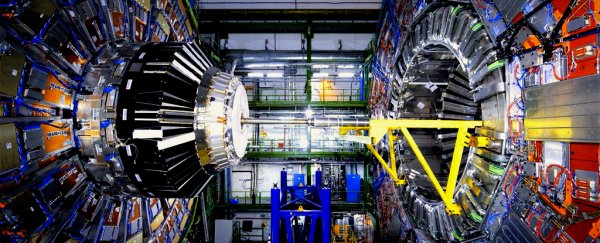Past experiments using CERN's super-sized particle-smasher, the Large Hadron Collider (LHC), hinted at something unexpected. A particle called a beauty meson was breaking down in ways that just weren't lining up with predictions.
That means one of two things – our predictions are wrong, or the numbers are out. And a new approach makes it less likely that the observations are a mere coincidence, making it nearly enough for scientists to start getting excited.
A small group of physicists took the collider's data on beauty meson (or b meson for short) disintegration, and investigated what might happen if they swapped one assumption regarding its decay for another that assumed interactions were still occurring after they transformed.
The results were more than a little surprising. The alternative approach doubles down on the take that something strange really is going on.
In physics, anomalies are usually viewed as good things. Fantastic things. Unexpected numbers could be the window to a whole new way of seeing physics.
Physicists are quite a conservative bunch. You have to be when the fundamental laws of the Universe are at stake.
So when experimental results don't quite match up with the theory, it's first presumed to be a random blip in the statistical chaos of a complicated test. If a follow-up experiment shows the same thing, it's still presumed to be 'one of those things'.
But after enough experiments, sufficient data can be collected to compare the chances of errors with the likelihood that something truly interesting is going on.
If an unexpected result differs from the predicted outcome by at least three standard deviations it's called a 3 sigma, and physicists are allowed to look at the results while nodding enthusiastically with their eyebrows raised. It becomes an observation.
To really attract attention, the anomaly should persist when there's enough data to push that difference to five standard deviations. A 5 sigma event is cause to break out the champagne.
Over the years, the LHC has been used to create particles called mesons, with the purpose of watching what happens in the moments after they're born.
Mesons are a type of hadron, somewhat like the proton. Only instead of consisting of three quarks in a stable formation under strong interactions, they're made of only two – a quark and an antiquark.
Even the most stable of mesons fall apart after hundredths of a second. The framework we use to describe the construction and decay of particles – the Standard Model – describes what we should see when different mesons split up.
The beauty meson is a down quark connected to a bottom anti-quark. When the particle's properties are plugged into the Standard Model, b-meson decay should produce pairs of electrons and positrons, or electron-like muons and their opposites, anti-muons.
This electron or muon outcome should be 50-50. But that's not what we're seeing. Results are showing far more of the electron-positron products than muon-anti-muons.
This is worth paying attention to. But when the sum of the results are held up next to the Standard Model's prediction, the difference is a mere 3.4 sigma. Interesting, but nothing to go wild over.
The Standard Model is a fine piece of work. Built over decades on the foundations of the field theories first laid out by the brilliant Scottish theorist James Clerk Maxwell, it's served as a map for the unseen realms of many new particles.
But it's not perfect. There's things we've seen in nature – from dark matter to the masses of neutrinos – that currently seem to be out of reach of the Standard Model's framework.
In moments like this, physicists tweak basic assumptions on the model and see if they do a better job of explaining what we're seeing.
"In previous calculations, it was assumed that when the meson disintegrates, there are no more interactions between its products," says physicist Danny van Dyk from the University of Zurich.
"In our latest calculations we have included the additional effect: long-distance effects called the charm-loop."
The details of this effect aren't for the amateur, and aren't quite Standard Model material.
In short, they involve complicated interactions of virtual particles – particles that don't persist long enough to go anywhere, but arise in principle in the fluctuations of quantum uncertainty – and an interaction between the decay products after they've split up.
What is interesting is that by explaining the meson's breakdown through this speculative charm loop the anomaly's significance jumps to a convincing 6.1 sigma.
In spite of the leap, it's still not a champagne affair. More work needs to be done, which includes piling up the observations in light of this new process.
"We will probably have a sufficient amount within two or three years to confirm the existence of an anomaly with a credibility entitling us to talk about a discovery," says Marcin Chrzaszcz from the University of Zurich.
If confirmed it would show enough flexibility in the Standard Model to stretch its boundaries, potentially revealing pathways to new areas of physics.
It's a tiny crack, and still might turn up nothing. But nobody said solving the biggest mysteries in the Universe would be easy.
This research was published in European Physical Journal C.
